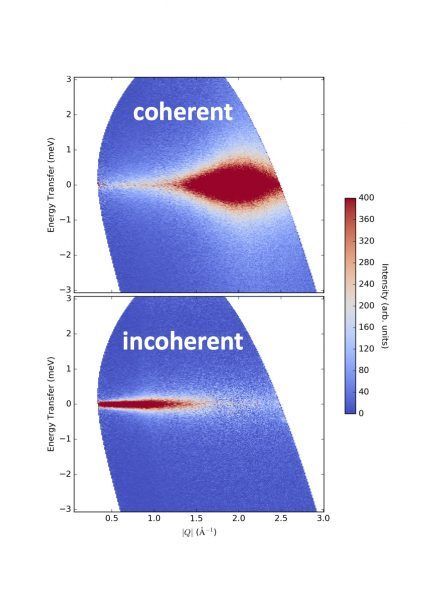Coherent structural relaxation of water from meso- to inter-molecular scales measured using neutron spectroscopy with polarization analysis
Applying recently implemented neutron scattering polarization analysis capabilities at the time-of-flight spectrometer LET (ISIS Neutron and Muon Source, UK), the authors report the separate measurement of the coherent and incoherent dynamic structure factor of heavy water with high resolution and in a wide range of scattering vector, for the first time.
The collective dynamics of water in the terahertz range has been intensively investigated since the 1970’s. Most studies used Inelastic X-ray Scattering (IXS), and invoked a viscoelastic model that assumes the existence of a “structural” relaxation process. A direct observation by IXS of this relaxation is, however, difficult due to the current resolution of IXS. IXS is also usually limited to mesoscopic scales (scattering vector 0.2 ≤ Q ≤ 0.7Å-1). Thus, the crossover towards the inter-molecular scale (Q ≈ 2Å-1 for water) had not been well explored up to now.

Figure: Projections of coherent and incoherent contributions to the neutron intensity scattered by D2O at 295 K and separated by PA.
Quasielasic Neutron Scattering is the ideal technique to directly observe the structural relaxation in a wide Q-range and with high-energy resolution. However, the intensity always contains coherent and incoherent contributions. The LET spectrometer with polarization analysis allowed separately measuring coherent and incoherent dynamic structure factor of heavy water with sub-meV resolution in a wide Q range (Figure 1). This breakthrough experiment revealed a striking decoupling of collective and single-particle motions completely hidden in previous experiments. At mesoscales, the decorrelation of the collective fluctuations hardly depends on Q. The directly deduced characteristic time for the structural relaxation there agrees well with that deduced from IXS. In the crossover range towards inter-molecular scales, the results are nicely described by the convolution of a Q-independent mode and diffusion. The combination with Molecular Dynamics simulations carried out at the Materials Physics Centre was very helpful for the data interpretation.
This work is a reference for future studies involving water under different conditions or as one of the components, influencing fields as broad and diverse as biology, soft matter or geology. In addition, it illuminates one of the most crucial open questions for liquids and glass-forming systems: the collective dynamics in the region of intermediate length scales, and how it develops toward the intermolecular ones.



